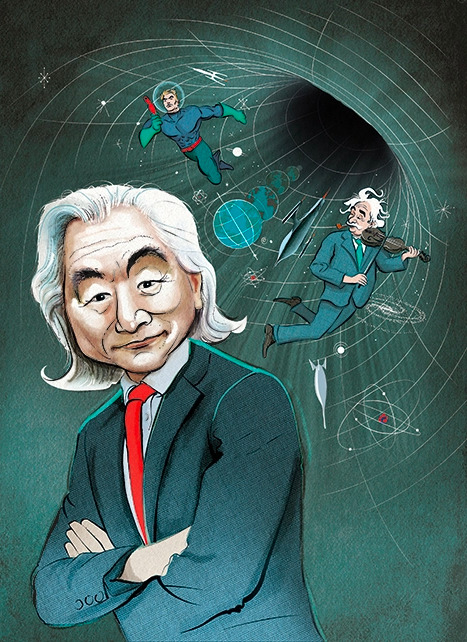
Dr. Sanjay Gupta: Explains the Science of Mouth-Taping
There’s a new sleep trend making waves: taping your mouth shut at night. Advocates say it can help you breathe better, sleep deeper, and even…
Thought Leader: Sanjay Gupta

f you’ve ever wondered how an invisibility cloak would work, how to terraform Mars, how to make a forcefield, whether we’re living in a Matrix-like simulation or how far we are from a working teleportation device, Michio Kaku is your man. In books such as Physics of the Impossible, Physics of the Future and Parallel Worlds, Kaku combines the scientific chops of the theoretical physics professor he is with the gee-wow wonder of a sci-fi geek.
That’s apt for someone who grew up worshipping at the twin altars of Albert Einstein and Flash Gordon. ‘It all started when I was eight,’ he says. ‘All the newspapers said that a great scientist had died. And they said that on his desk was a manuscript that he could not finish. I was fascinated by that. And so I looked up who was this man who could not finish this book. What was in it? Well, the man’s name was Albert Einstein. And that book was to be the theory of everything. An equation perhaps no more than one inch long that would allow us to “read the mind of God”. Well, I was fixed. I was fascinated. I had to know what was in that book.’
When the eight-year-old Kaku (who, by the way, went on to dismay his mother by building a particle collider in the family garage in San Jose for a school science project) found nothing in the library that could explain Einstein’s theory to a child, he turned to science fiction. ‘It’s all there in the original Flash Gordon series: ray guns, invisibility, extra-terrestrial civilisations, nuclear energy.’ He is adamant that the two great passions of his life – ‘the unified field theory on one hand and science fiction on the other’ – are ‘related to each other’.
His new book, Quantum Supremacy, argues – here I simplify, but not much – that quantum computers are going to be the solution to all mankind’s problems, and that shift from the digital to the quantum age will be a greater leap than the original digital revolution. ‘Everything,’ he says, ‘everything about the economy, medicine, warfare – everything is going to be turned upside down.’ Why? Because quantum computers are unimaginably more powerful than the digital sort.
Digital computers work with ‘bits’, noughts and ones, ‘a very crude approximation of reality’. But quantum computers use the qubit – the state of an atom – as a unit of computation. As we know from quantum theory, atoms can point up or down, but also spin: ‘There are infinitely more states than just zeros and ones… the digital revolution will look like an abacus.’ To give a sense of how fast that scales, in 2019 Google reported that its 53-qubit Sycamore computer could solve in 200 seconds a mathematical problem that would take the fastest digital computer 10,000 years to finish. Last year, IBM unveiled a 433-qubit quantum computer. The 1,121-qubit follow-up is due any day, and it hopes to have a 4,000-qubit version working by 2025.
‘There are infinitely more states than just zeros and ones… the digital revolution will look like an abacus’
So the field is moving fast. Quantum supremacy – the point at which a quantum computer kicks a digital computer’s ass – is in the rear-view mirror. The only problem is that for quantum computers to work, so far, they need to be cooled to very near absolute zero. ‘You have to cool it down to where all the extraneous vibrations and noise are eliminated,’ Kaku explains. ‘Somebody’s burping. Somebody’s jumping up and down. A car backfiring a block away would ruin a quantum calculation.’ A whole range of different approaches are even now competing worldwide to get the edge on making bigger quantum computers faster.
When they get there, though, they will transform everything. Digital computers simply don’t have the capacity to model chemical reactions at the molecular level. Quantum computers will. ‘Chemical reactions are mediated by electrons. Electrons are described by waves. Waves are probability,’ Kaku says. ‘Where are the zeros and ones? Nowhere to be seen. A zero and a one is an approximation, a crude approximation, to a wave. And that wave is the wave of an electron. Why is that important? Because that electron gives you cancer, gives you wellbeing, gives you solar energy, gives you fusion power. Mother Nature is quantum mechanical. The universe is in some sense a quantum computer.’
That means, if I understand him rightly, that quantum computers will allow us to do chemistry without chemicals. Everything from batteries to vaccines is currently invented, effectively, by trial and error: but if you can accurately simulate chemical reactions, you don’t need bubbling flasks. The secrets of everything from human ageing to photosynthesis (a near 100 per cent efficient quantum process that, Kaku reminds us in tones of wonder, takes place at room temperature) can be unlocked.
Pleasingly, some of the first and most important possibilities he sets out are `very material ones. The century-old Haber Process for making fertiliser out of atmospheric nitrogen has made it possible to feed billions who would not otherwise be alive today, but it consumes fully 2 per cent of all the world’s energy. Quantum computing could give us the ability to ‘fix’ nitrogen without the huge temperatures and pressures required – ushering in a new green revolution.
In the medical domain, quantum computers will be able to analyse how drugs work at a molecular level, model and test new ones without ever going near a patient, and analyse the vast and noisy datasets that will allow medics to spot the outbreak of a new pandemic long before humans could. Kaku envisions quantum computers sniffing out cancer ‘years to decades before tumours form’ with routine ‘liquid biopsies’ performed by a ‘smart toilet’ in your home.
On the cosmic level, as well as predicting asteroid strikes, solar flares, gamma-ray bursts and other planet-threatening nasties, quantum computers will allow us to model the life cycle of stars, create stable fusion reactors, and interpret the flood of data coming out of the successor to the Large Hadron Collider. Quantum computers, he says, are the tools we need to deal with problems in physics whose maths can’t be handled by digital computers – among them the mind-bending Planck energy (‘ten to the 29th power: the energy of the Big Bang… way beyond anything that we can create on the planet Earth’), the mysteries of dark matter(‘It’s very embarrassing that most of the universe is dark matter and we don’t know what it is’), and even the twisting of space-time beyond the event horizons of black holes, where it’s thought ‘wormholes’ to parallel universes may form.
In Kaku’s account of it, then, there doesn’t seem to be a human problem that quantum computers won’t be able to fix. The only fly in the ointment, as he mentions not very much more than en passant, is that between here and all the good stuff there are a couple of potential road-bumps.
Quantum computers may indeed get round to abolishing disease, hunger and global warming. But, even leaving aside the ‘control problem’ when quantum computers give the development of AI a hyper-speed boost, the first thing that they’ll do along the way is to make it possible to break by ‘brute force’ (i.e. sheer computational welly) every form of encryption on the planet. So, potentially, goodbye to all military and civilian secrets, not to mention the secure transactions on which the entire global financial system depends. And with world powers competing to get first-mover advantage in the quantum computing realm, that gives the phrase ‘Quantum Supremacy’ a geopolitical shading. Isn’t that something that worries him just the teeniest little bit?
‘Yes,’ he concedes. ‘What branch of the government is most interested in advancements in this technology? It’s the CIA. Government agencies are already beginning to issue statements saying: “Be prepared, start to make changes now in your behaviour, because when this revolution is in full blast, it means that all your secrets can be read by your next-door neighbour.” We’re not at the point where we have to worry about this technology every day. But it’s coming.’
The likely defence against this sort of disaster, he says, is ‘use quantum to defeat quantum’. ‘Another idea is to have a dual internet: one internet that can never be broken because it’s all based on laser beams and the quantum principle, and the other one we use, you and me, that can be broken if you have a powerful enough quantum computer.’ A laser internet, he says, could use quantum principles to incorporate tripwires. Laser beams are polarised, meaning they vibrate in only one plane and that plane changes when they are interfered with: ‘By looking at the change in the direction of the polarisation, immediately you know that somebody is trying to hack into your system and then you can take safeguards to kick them out.’
But: ‘We’re talking about ten, 15 years in the future when quantum computers are so powerful they can break any code. And then, of course, the CIA has a nervous breakdown trying to figure out all the different ways we can use the quantum principle to defeat the quantum principle.’ Cross that bridge when we come to it, then.
Quantum Supremacy, along the way, not only explains in layman’s terms how these things work, but gives vivid sketches of some of the scientists who have laid the groundwork for the quantum revolution – many of whom, such as Stephen Hawking and Richard Feynman, Kaku has met and worked with. The book’s Acknowledgements has a separate section for the ‘many Nobel Laureates that I have consulted with or interviewed who provided invaluable advice’. There are 16 of them. I wonder if Kaku has an idea about what drives physicists at that level.
‘Well, one thing when you encounter these individuals,’ he says, ‘is that you have to throw away common sense. Everything you thought you knew about the world is wrong. You have to talk to individuals who are willing to open their minds to the impossible. Ever since we were children, we were told you cannot be two places at the same time. Actually, at the quantum level, you can be in an infinite number of places at the same time. Einstein said, “The more successful the quantum theory becomes, the sillier it looks”. And it’s absolutely true. It’s a silly theory, but get used to it. The world is quantum mechanical independent of your classical mind.’
‘What branch of the government is most interested in advancements in this technology? It’s the CIA’
It’s not just the wildness of theoretical physics that attracts Kaku, but the aesthetics: the instinct that a profound truth must be beautiful or simple or both remains strong in the field, as witness the fabulous simplicity and generative power of the Schrödinger equation (from which all chemistry proceeds) or, for that matter, E=mc2. Kaku’s dissatisfaction with the Standard Model of particles – which gives us four forces, 12 particles and a boson – is, he writes, at least in part because it is such a mess: ‘A theory only a mother could love. It’s like putting an aardvark, platypus and whale together with Scotch tape, and calling it nature’s finest creation.’
The proposed successor to the Standard Model is Kaku’s own academic specialism, string theory, which he calls ‘crazy… but the only game in town’. It’s certainly beautiful. ‘Those of us who work in string theory, we think the final theory is based on music. Music is based on vibrating strings. Each vibration corresponds to a particle, so the electron vibrates this way, a proton vibrates this way and a neutron vibrates this way. They’re nothing but musical notes.
‘So physics is the harmonies that you can create on musical forms. Chemistry is the melodies that you can create out of these musical notes. The universe is a symphony of strings, and then the mind of God, the mind of God that Einstein wrote about for the last 30 years of his life, would be cosmic music resonating through hyperspace.’
So the ancients’ idea of the music of the spheres – a heavenly symphony arising from the proportions of the planetary bodies in space – might after all have been in the right direction? ‘That is the only paradigm rich enough to explain the diversity of everything there is,’ says Kaku. ‘The atomic theory simply says there are atoms. It doesn’t explain why. String theory says it’s all music. Music that obeys harmonies. And these harmonies are the laws of physics.’
He adds: ‘Once I gave a talk at Aspen in Colorado, which is where theoretical physicists go to recharge their batteries, and Richard Feynman was in the audience. I gave an introductory talk on string theory. Feynman was famous for putting down rival theories: one phrase, one slight joke would just send the whole audience laughing and humiliate the speaker. So I was a little bit apprehensive. Feynman was a critic of string theory. He didn’t quite think it was philosophically his cup of tea. After I finished my talk he came up to me. And I said, OK, here it comes. He said: “This talk was one of the most beautiful talks I’ve ever heard. Gorgeous. Maybe it’s all wrong. But it was gorgeous.” I began to realise that, well, the power of beauty will sway some of the greatest minds. So that was rather encouraging – knowing that even though I could be wrong, the theory had emotional power to resonate within the human mind.’
For Kaku, resonating in the human mind is a blessing but proving it would be the real prize. The way string theory is tested involves ‘lattice quantum chromodynamics’: a calculation problem far beyond what digital computers can achieve. ‘Quantum computers,’ he writes, ‘may be the final step in finding the Theory of Everything.’
‘I’m not a computer person. I’m a theoretical physicist,’ he says. ‘But I got into quantum computers because I realised this may be the only way to quantitatively prove that string theory is correct. String theory exists in the multiverse. That is, we exist perhaps in parallel states which are bizarre, with new laws of physics, but we coexist with them. The way to prove it is with a quantum computer.’
Such a proof would shed light on a question that Einstein thought was one of the most profound that could be asked: did God have a choice in making the universe? ‘Einstein thought that there was no choice,’ says Kaku. ‘The universe had to be this way because any other way it would fall apart.’ Do you believe in God yourself? I ask him. ‘I believe in the God of Einstein: that the universe in some sense was not an accident, that the universe is not just chaotic – that there really is a rhyme or reason to the universe.’
Dr. Sanjay Gupta: Explains the Science of Mouth-Taping
There’s a new sleep trend making waves: taping your mouth shut at night. Advocates say it can help you breathe better, sleep deeper, and even…
Thought Leader: Sanjay Gupta
Joe Grogan: The Alzheimer’s Economic Threat
Social Security could become insolvent in as little as eight years, with more people retiring and living longer and fewer paying into the program. Alzheimer’s disease is…
Thought Leader: Joseph Grogan
Evan Feigenbaum on the outcomes of Putin’s India visit
Evan Feigenbaum of the Carnegie Endowment for International Peace argues that none of India’s major challenges can be meaningfully addressed by deepening ties with Russia.…
Thought Leader: Evan Feigenbaum

